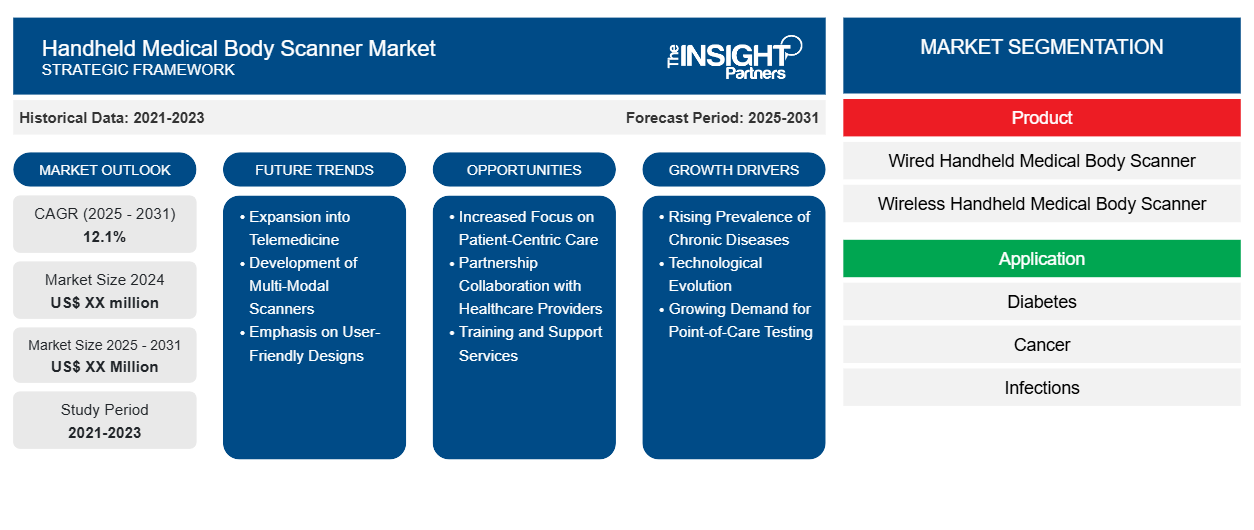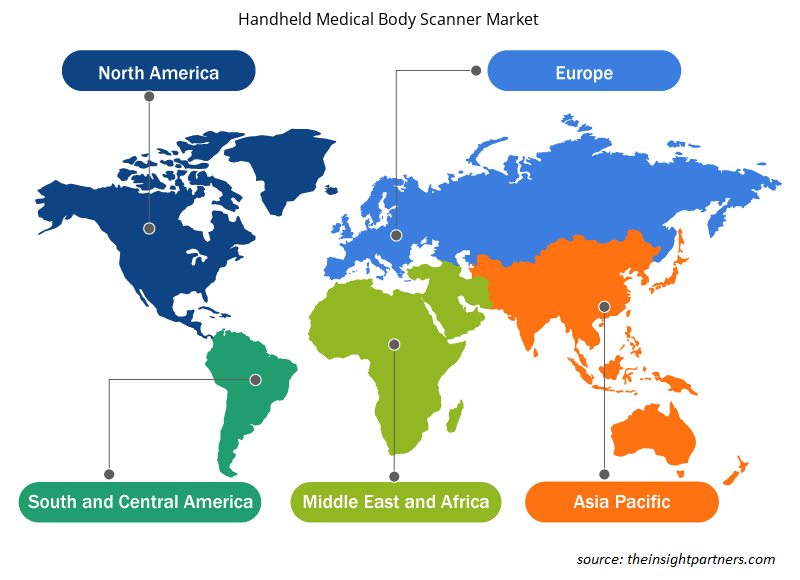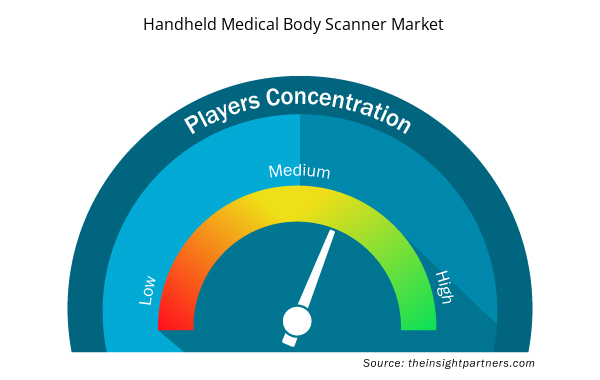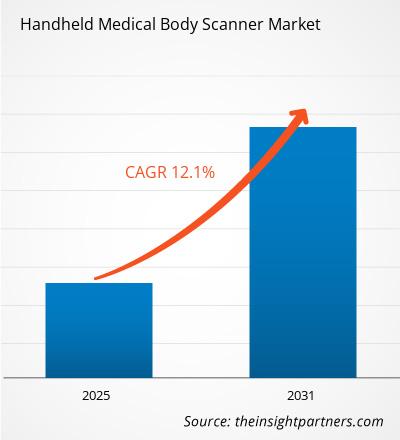The Handheld Medical Body Scanner Market is expected to register a CAGR of 12.1% from 2025 to 2031, with a market size expanding from US$ XX million in 2024 to US$ XX Million by 2031.
The report is segmented by Product (Wired Handheld Medical Body Scanner, Wireless Handheld Medical Body Scanner). The report is further segmented based on Application (Diabetes, Cancer, Infections, Others). Futher, it is segmented based on End User (Hospitals, Clinics, Diagnostic Centers, Others). The global analysis is further broken-down at regional level and major countries. The report offers the value in USD for the above analysis and segments.
Purpose of the Report
The report Handheld Medical Body Scanner Market by The Insight Partners aims to describe the present landscape and future growth, top driving factors, challenges, and opportunities. This will provide insights to various business stakeholders, such as:
- Technology Providers/Manufacturers: To understand the evolving market dynamics and know the potential growth opportunities, enabling them to make informed strategic decisions.
- Investors: To conduct a comprehensive trend analysis regarding the market growth rate, market financial projections, and opportunities that exist across the value chain.
- Regulatory bodies: To regulate policies and police activities in the market with the aim of minimizing abuse, preserving investor trust and confidence, and upholding the integrity and stability of the market.
Handheld Medical Body Scanner Market Segmentation
Product
- Wired Handheld Medical Body Scanner
- Wireless Handheld Medical Body Scanner
Application
- Diabetes
- Cancer
- Infections
- Others
End User
- Hospitals
- Clinics
- Diagnostic Centers
- Others
Geography
- North America
- Europe
- Asia-Pacific
- South and Central America
- Middle East and Africa
Customize This Report To Suit Your Requirement
You will get customization on any report - free of charge - including parts of this report, or country-level analysis, Excel Data pack, as well as avail great offers and discounts for start-ups & universities
Handheld Medical Body Scanner Market: Strategic Insights

- Get Top Key Market Trends of this report.This FREE sample will include data analysis, ranging from market trends to estimates and forecasts.
Handheld Medical Body Scanner Market Growth Drivers
- Rising Prevalence of Chronic Diseases: More and more patients now suffer from chronic diseases such as cancer and heart disease. Therefore, advanced diagnostic tools are in demand. Handheld medical body scanners enable the early detection and monitoring of these diseases thereby enhancing patients' outcomes, too, and also the provision of a comprehensive health service for that matter.
- Technological Evolution: Innovations in imaging technology in sensor and imaging algorithms are advancing the handheld medical body scanner market. Higher resolutions from a smaller device with increased scanning speed prove the handheld medical body scanner attractive to healthcare providers who have always sought more efficient diagnostic tools.
- Growing Demand for Point-of-Care Testing: Increasing demand for point-of-care testing is proving to be a great growth influencer for portable medical body scanners. Since these devices can make bedside testing possible right at the place of care delivery, their benefits include saving time, downsizing the volume of laboratory testing through interventions that take place in real time at the bedside, and reducing the time to clinical decision-making-a factor that may speed up the treatment of patients, most importantly in emergency situations.
Handheld Medical Body Scanner Market Future Trends
- Expansion into Telemedicine: This is an expanding area where handheld medical body scanners are being used to diagnose a patient from a distance. In that case, healthcare providers may make assessments and monitor patients to close the access gaps and improve their health outcomes.
- Development of Multi-Modal Scanners: There is also the trend in developing handheld scanners with multi-modal capabilities where the user will be able to apply various imaging techniques, like ultrasound or X-ray in one device. This presents stronger diagnostic capability and provides providers with one single tool capable of handling large portions of a patient assessment process.
- Emphasis on User-Friendly Designs: The style in hand-held medical body scanners is gaining emphasis towards user-friendliness. Intuitive interfaces, lightweight structures, and ergonomic designs are essential features that ensure health professionals can operate these devices effectively and very efficiently in the most pressured situations.
Handheld Medical Body Scanner Market Opportunities
- Increased Focus on Patient-Centric Care: Increased emphasis on patient-centric care within the health sector led to an increased demand for portable and user-friendly devices that are likely to be used in diagnosing patients. Handheld medical body scanners increase the convenience levels for patients and doctors, thereby enhancing patients' satisfaction levels and their engagement with the treatment process.
- Partnership Collaboration with Healthcare Providers: Collaborate with healthcare providers in designing customized handheld scanning solutions. Opportunities here can be taken by developing new innovations suited to the needs of the hospital or clinic; such a partnership will drive adoptions and market shares.
- Training and Support Services: Another means to improve user satisfaction is by providing training and support services to healthcare professionals who use handheld medical body scanners. Education related to these devices on proper usage can make a difference in improved outcomes in patients, thereby increasing loyalty to manufacturers.
Handheld Medical Body Scanner Market Regional Insights
The regional trends and factors influencing the Handheld Medical Body Scanner Market throughout the forecast period have been thoroughly explained by the analysts at Insight Partners. This section also discusses Handheld Medical Body Scanner Market segments and geography across North America, Europe, Asia Pacific, Middle East and Africa, and South and Central America.

- Get the Regional Specific Data for Handheld Medical Body Scanner Market
Handheld Medical Body Scanner Market Report Scope
| Report Attribute | Details |
|---|---|
| Market size in 2024 | US$ XX million |
| Market Size by 2031 | US$ XX Million |
| Global CAGR (2025 - 2031) | 12.1% |
| Historical Data | 2021-2023 |
| Forecast period | 2025-2031 |
| Segments Covered |
By Product
|
| Regions and Countries Covered | North America
|
| Market leaders and key company profiles |
Handheld Medical Body Scanner Market Players Density: Understanding Its Impact on Business Dynamics
The Handheld Medical Body Scanner Market market is growing rapidly, driven by increasing end-user demand due to factors such as evolving consumer preferences, technological advancements, and greater awareness of the product's benefits. As demand rises, businesses are expanding their offerings, innovating to meet consumer needs, and capitalizing on emerging trends, which further fuels market growth.
Market players density refers to the distribution of firms or companies operating within a particular market or industry. It indicates how many competitors (market players) are present in a given market space relative to its size or total market value.
Major Companies operating in the Handheld Medical Body Scanner Market are:
- CREAFORM
- Butterfly Network, Inc.
- Clarius Mobile Health.
- Koninklijke Philips N.V.
- FUJIFILM Sonosite, Inc.
Disclaimer: The companies listed above are not ranked in any particular order.

- Get the Handheld Medical Body Scanner Market top key players overview
Key Selling Points
- Comprehensive Coverage: The report comprehensively covers the analysis of products, services, types, and end users of the Handheld Medical Body Scanner Market, providing a holistic landscape.
- Expert Analysis: The report is compiled based on the in-depth understanding of industry experts and analysts.
- Up-to-date Information: The report assures business relevance due to its coverage of recent information and data trends.
- Customization Options: This report can be customized to cater to specific client requirements and suit the business strategies aptly.
The research report on the Handheld Medical Body Scanner Market can, therefore, help spearhead the trail of decoding and understanding the industry scenario and growth prospects. Although there can be a few valid concerns, the overall benefits of this report tend to outweigh the disadvantages.
- Historical Analysis (2 Years), Base Year, Forecast (7 Years) with CAGR
- PEST and SWOT Analysis
- Market Size Value / Volume - Global, Regional, Country
- Industry and Competitive Landscape
- Excel Dataset



Report Coverage
Revenue forecast, Company Analysis, Industry landscape, Growth factors, and Trends

Segment Covered
This text is related
to segments covered.

Regional Scope
North America, Europe, Asia Pacific, Middle East & Africa, South & Central America

Country Scope
This text is related
to country scope.
Frequently Asked Questions
The major factors driving the handheld medical body scanner market are:
1. Technological Evolution.
2. Growing Demand for Point-of-Care Testing.
North America region accounts for highest revenue share in handheld medical body scanner market.
Asia Pacific is estimated to grow at the highest CAGR over the forecast period (2023 - 2031).
The handheld medical body scanner market is expected to grow at a CAGR of 12.1%.
The final report will duly include market size and projection estimates for all the segments from 2021 to 2031, along with a revenue share and compound annual growth rate (%) for the regional/country-wise market wherein 2021-2022 are the historic years, 2023 is considered to be the base year, and the forecast will be provided till 2031, along with CAGR (%).
Koninklijke Philips N.V., FUJIFILM Sonosite, and GE Healthcare are the major companies operating in the handheld medical body scanner market.
Trends and growth analysis reports related to Life Sciences : READ MORE..
1. CREAFORM
2. Butterfly Network, Inc.
3. Clarius Mobile Health.
4. Koninklijke Philips N.V.
5. FUJIFILM Sonosite, Inc.
6. Healcerion Co., Ltd.
7. Meditech Equipment Co.,Ltd
8. TERASON DIVISION TERATECH CORPORATION.
9. Sonostar Technologies Co., Limited
10. GENERAL ELECTRIC COMPANY

 Get Free Sample For
Get Free Sample For